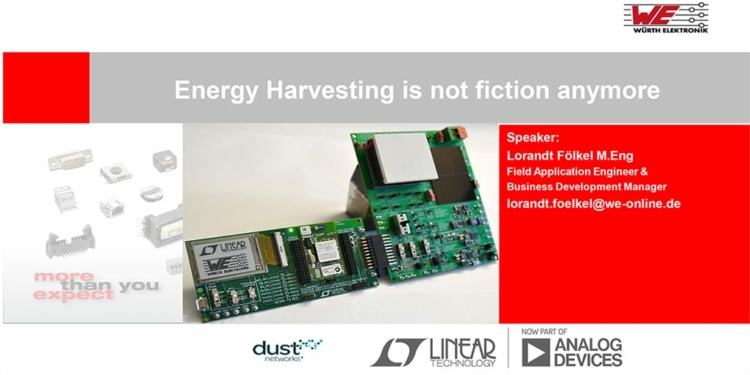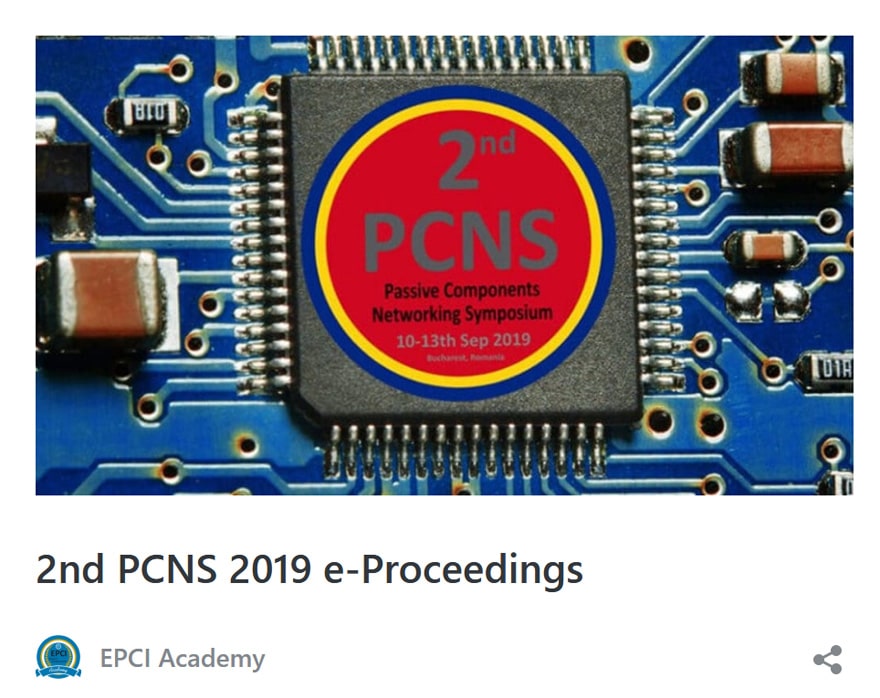Source: EPCI PCNS e-Symposium paper
by Lorandt Foelkel M.Eng; Würth Elektronik eiSos
presented by Paul Le Nezet at the 2nd PCNS 10-13th September 2019, Bucharest, Romania as paper 2.1.
ABSTRACT
The paper introduces overview of state of the art on energy harvesting. It discus what type of ambient energies are available, what are the challenges in converting (& storing) these energies into usable energy and showing examples of real life use cases demonstrating that Energy Harvesting has already progressed from the laboratory to commercial applications.
INTRODUCTION
Our environment is changing and everything is becoming “electronified”. Our glasses, our hand gloves, shirts, shoes etc., can be connected already today with our smartphones and can send commands to the machinery surrounding us. We want this comfort, and we are all looking forward to having Smart Homes. The point is, we’ve already built our houses, and we did not implement LAN CATx cables to our coffee machines or refrigerators; even all our lights don’t use PoE (Power over Ethernet).
If you build a new house and want to implement these data cables, you will not think twice about it due to the increase in cost. The alternative solution is to use wireless communication, but, at the same time, we don’t want to live in electro-smog, which all these devices are continuously emitting. Those devices should transmit only on request. Furthermore, the efficiency should not be negatively influenced, and we should all continue to look for ENERGY STAR certified devices.
We could use Wi-Fi in all those devices, and that could be the simplest and easiest way. However, the cost of implementation would be quite high, and additional technical knowhow for maintenance from the user’s side would be required. To solve this situation and to be cost effective, the design engineer will likely decide to use a proprietary SRD (Short Range Devices) system, where the ISM (Industrial, Scientific and Medical) Band is used.
ENERGY HARVESTING – OVERVIEW
Energy Harvesting = Energy for free?
Energy harvesting has recently become a topic of much discussion with its potential to self-power autonomous devices for wearables, medical devices and for IoT (the Internet of Things). Examples of real life use cases demonstrating that Energy Harvesting has already progressed from the laboratory to commercial applications. In general we need devices that are:
- Wireless (avoid power and communications cables)
- Totally autonomous
- Highly reliable with backup battery lifetime up to 15~20 years
We have to consider that the laws of physics are still valid. But wasted energy are everywhere, we just need to find them, convert them (harvest), transform them into electrical energy, store it for the time when not used and recall it when needed.
BASIC CONSIDERATIONS
First Step
We have to evaluate two system requirements as the first step:
- calculate the total energy demand for your system
- watch out for your peak energy demand
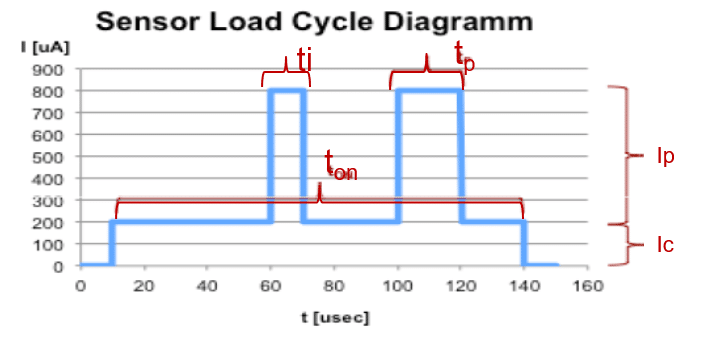

tp,i: pulse duration
Ic: continuous current
ton: system on time
Ip: pulsed current
DC: sequence duty cycle
Second Step
- consider the source capabilities
- check multiple source availability (solar, thermo, motion, chemical… etc.
- watch out for the stability over the time (use a data logger)
Third step:
- choose the right harvester (transducer)
- build the right voltage converter (source impedance matching)
- consider an energy storage for back up
- capacity bank
- supercaps
- ultracaps (Supercap/Lithium-Ion)
- Li-Pol rechargeable
WHERE TO FIND “FREE ENERGY”
Typical energy harvester output power
- RF: 0.1µW/cm²
- Vibration: 1mW/cm²
- Thermal: 10mW/cm²
- Photovoltaic: 100mW/cm²
Typical energy harvester voltages
- RF: 0.01mV
- Vibration: 0.1 ~ 0.4 V
- Thermal: 0.02 ~ 1.0 V
- Photovoltaic: 0.5 ~ 0.7 V typ./cell
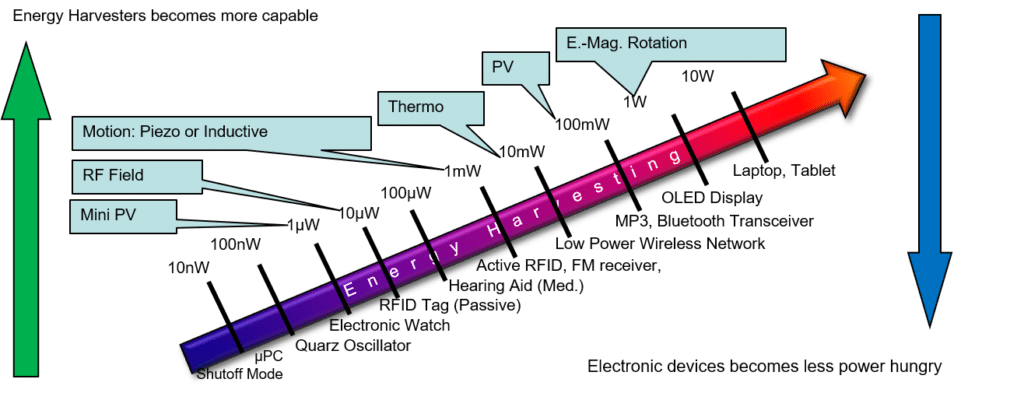
EXAMPLES OF ENERGY HARVESTER APPLICATIONS
Chip manufacturers [3] have introduced a new generation of processors to the market, which already have the built-in RF module in the chip itself. One example is an ARM Cortex M4 CPU platform, which can be used with up to a 48 MHz clock, and the RF stage can operate from 145 MHz to 1050 MHz for transmission (Rx/Tx).
This solution is amazing, has low current requirement, and can operate with just 40 nA@3V in Sleep Mode. In case of transmission, the current is 18 mA @ +10 dBm. At this point, we can start to harvest the energy from the ambient environment for the application, and power our device. For such a solution, a power converter manufacturer [4] developed a new chip, which is able to harvest from multiple sources. See Figure 3.

It can use a piezo or inductive harvester if we have movements/vibration; in case of temperature differences, we can harvest from a TEG (Thermo Electric Generator); or we can use the indoor solar input, and harvest the light from the ambient. All that, with just one single dc/dc converter chip. If we did harvest enough energy to power, and the harvested energy is still present, we can store it into a capacity bank with the same chip, then into a Supercap (balancer in chip), or even charge a Li-Ion battery. An additional input, for a backup battery, is also available in the same chip. If you want to try your first steps designing self-powered electronics, there are few kit’s available [5]. Now, with only 2 ICs, we can realize many projects and most ingenious self-powered devices with no maintenance at all.
Self-Powered Electronics
In case that are problems with energy & voltage levels & their sporadically, how can be solved. Much of the energy stored can be lost through leakage. Which tools/evaluation kits are available to develop self-powered electronics? New low power converter IC’s are developed which can be powered
from multiple harvester at same time and manage the energy to power extreme low power microprocessors which have RF modules build in and can communicate wireless and could be totally autonomous powered.
Imagine a 50 MHz micro Processor which is powered just from your body heat (TEG) or shaking few grams in your hand (electromagnetic harvester/transducer), this is enough energy to harvest than measure and display on a LCD the ambient temperature or to execute complex commands.
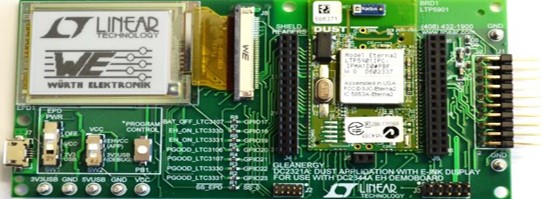
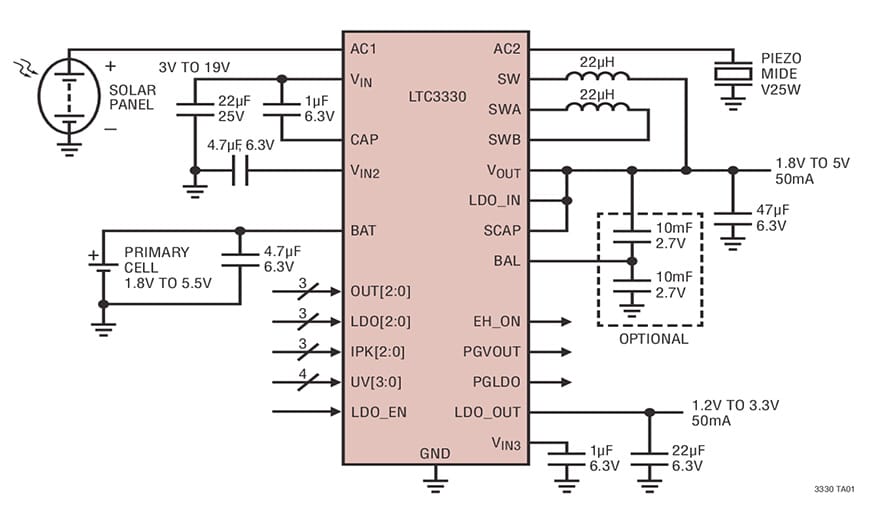
SUMMARY & CONCLUSION
Today they are new low power converter IC’s developed which can be powered at the same time from multiple harvested sources and manage the energy to supply very low power microprocessors which have already RF modules build in and can communicate wirelessly. Such devices, whatever IoT or just sensors, could be designed and build in such way that never need maintenance for battery change or even access to grid and can be totally autonomous powered from environment.
REFERENCES
- Lorandt Foelkel. Wurth Elektronik eiSos; “it” Intereference Technology https://interferencetechnology.com/energy-harvesting-not-fiction-anymore
- Lorandt Foelkel. Wurth Elektronik eiSos, all-electronics.de (German print media): https://www.all-electronics.de/technologiebotschafter-foelkel-wuerth
- Silicon Labs: EZR32™ Wireless MCUs with 142 MHz – 1050 MHz RF frequency range App Note http://www.silabs.com/products/wireless/proprietary/ezr32-wonder-gecko-sub-ghz
- Linear Technology: LTC3331 – Nanopower Buck-Boost DC/DC with Energy Harvesting Battery Charge App Note http://www.linear.com/product/LTC3331
- https://www.we-online.com/harvest
more 2nd PCNS symposium technical papers can be viewed and downloaded in pdf from EPCI Academy e-Proceedings:



















